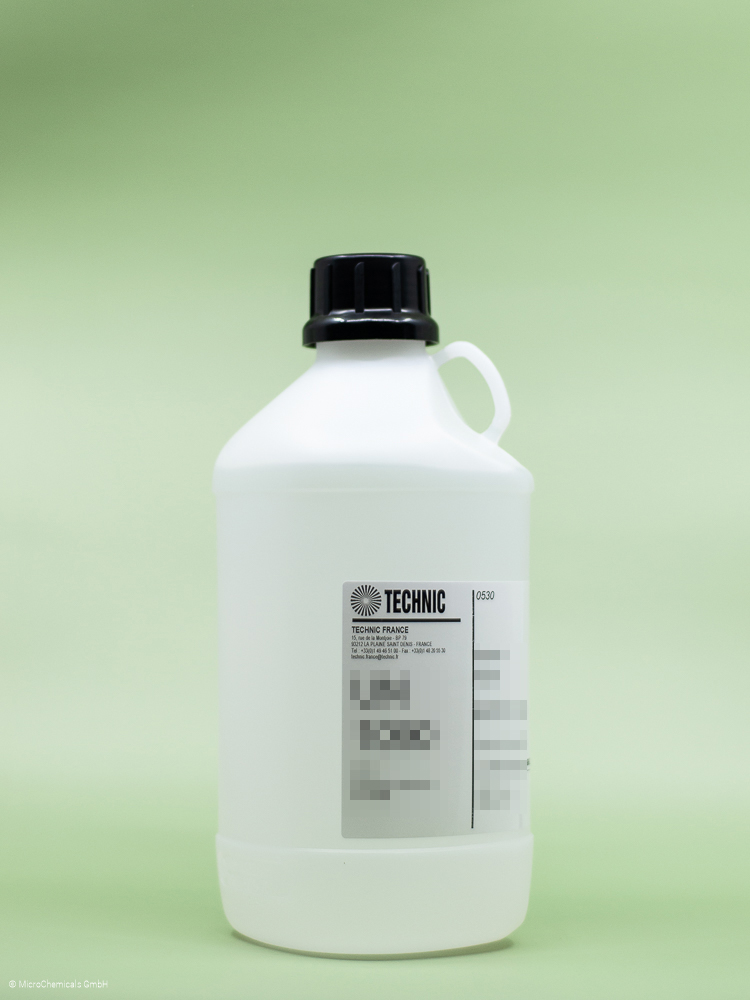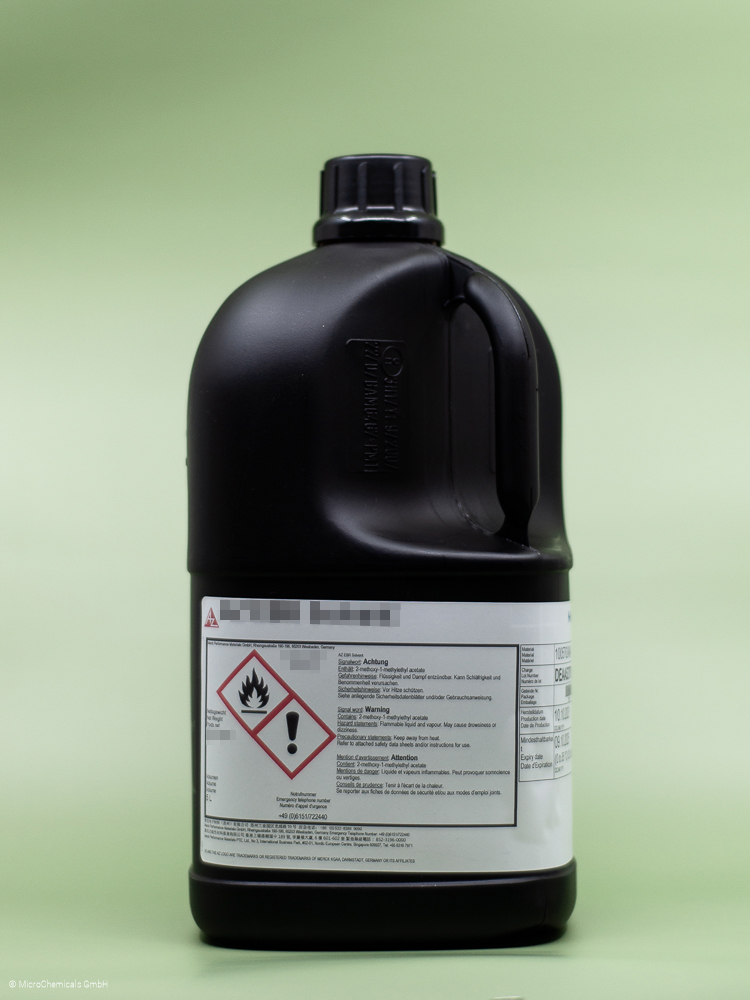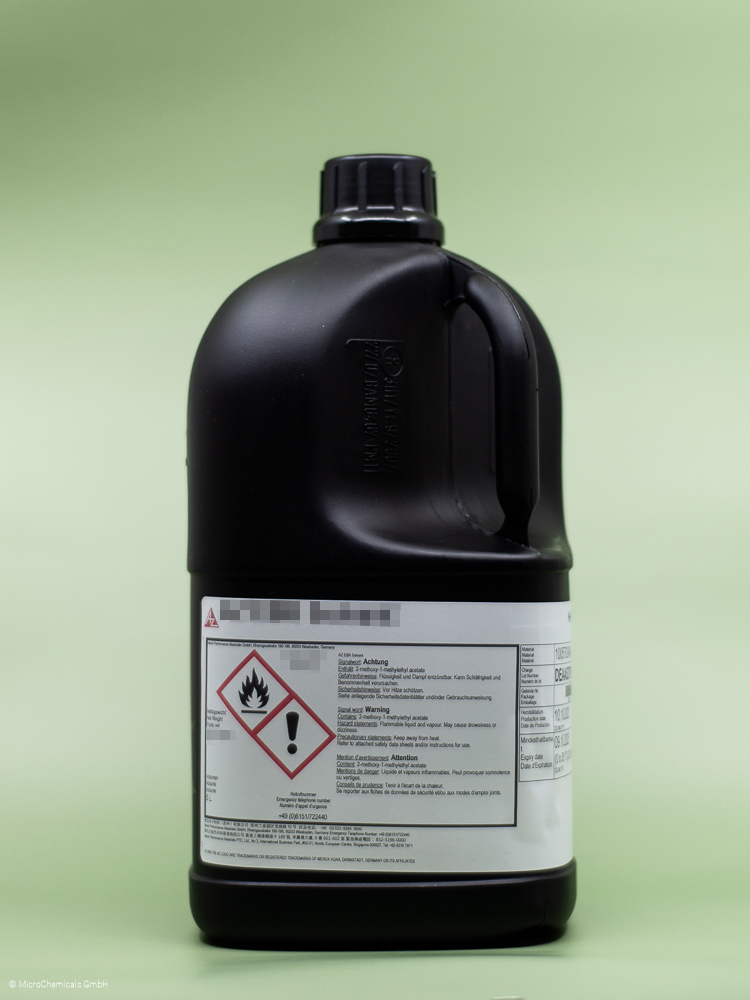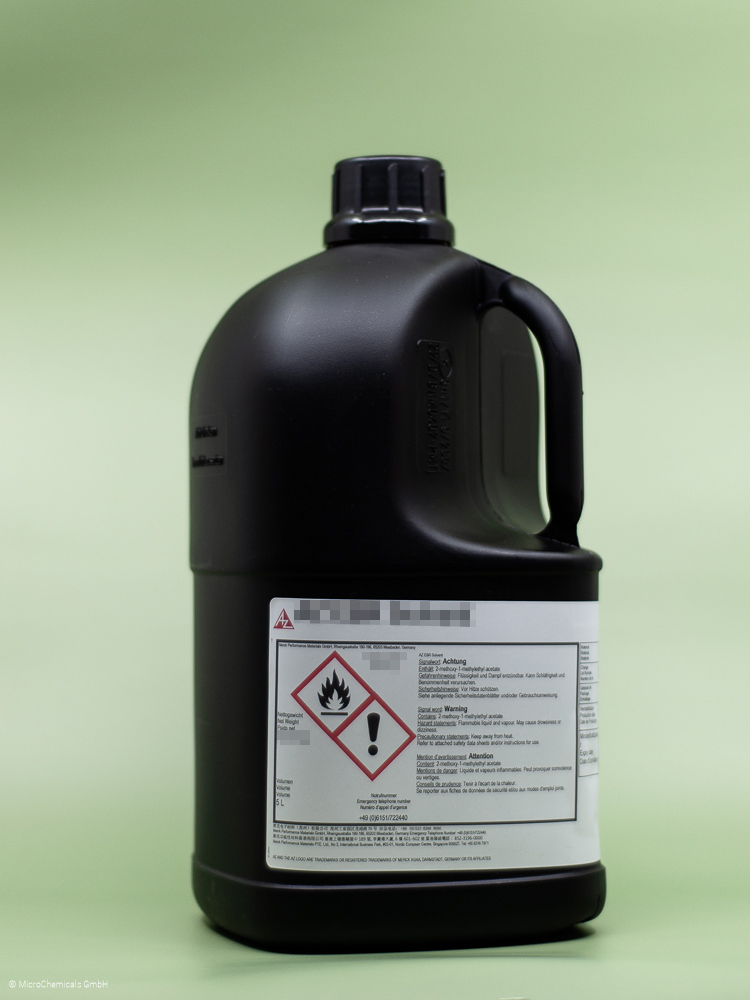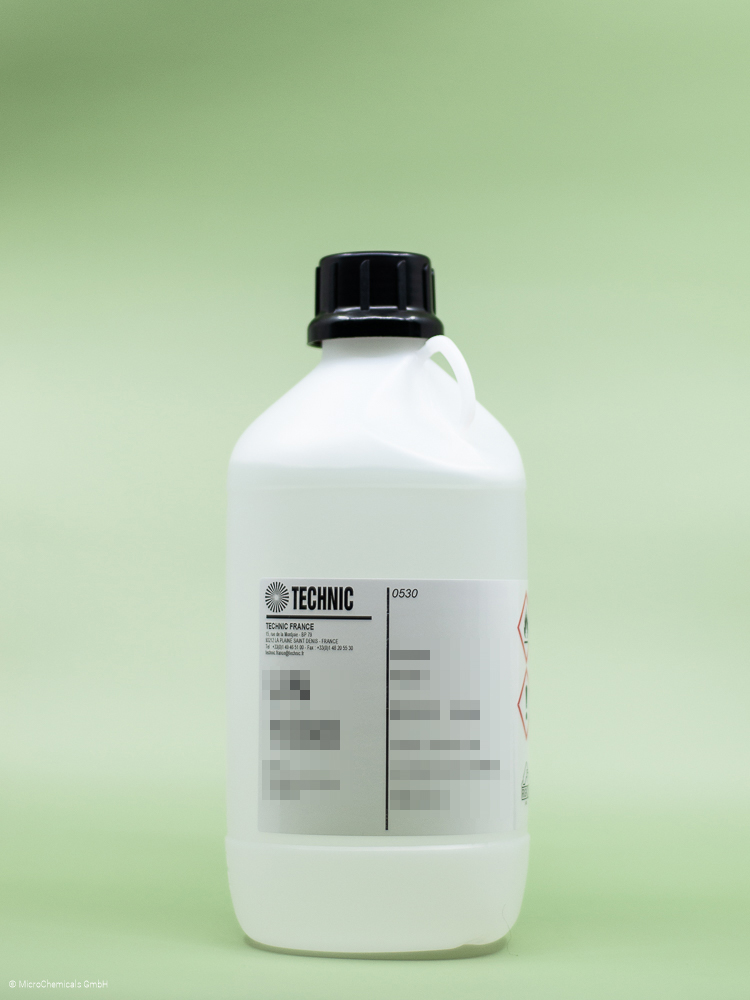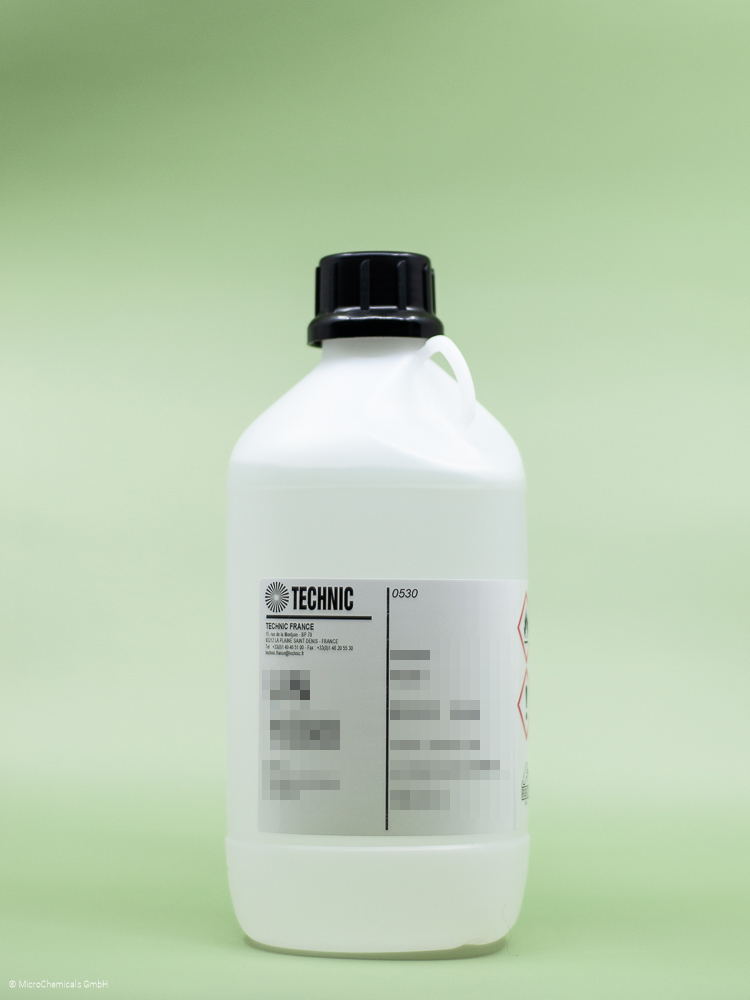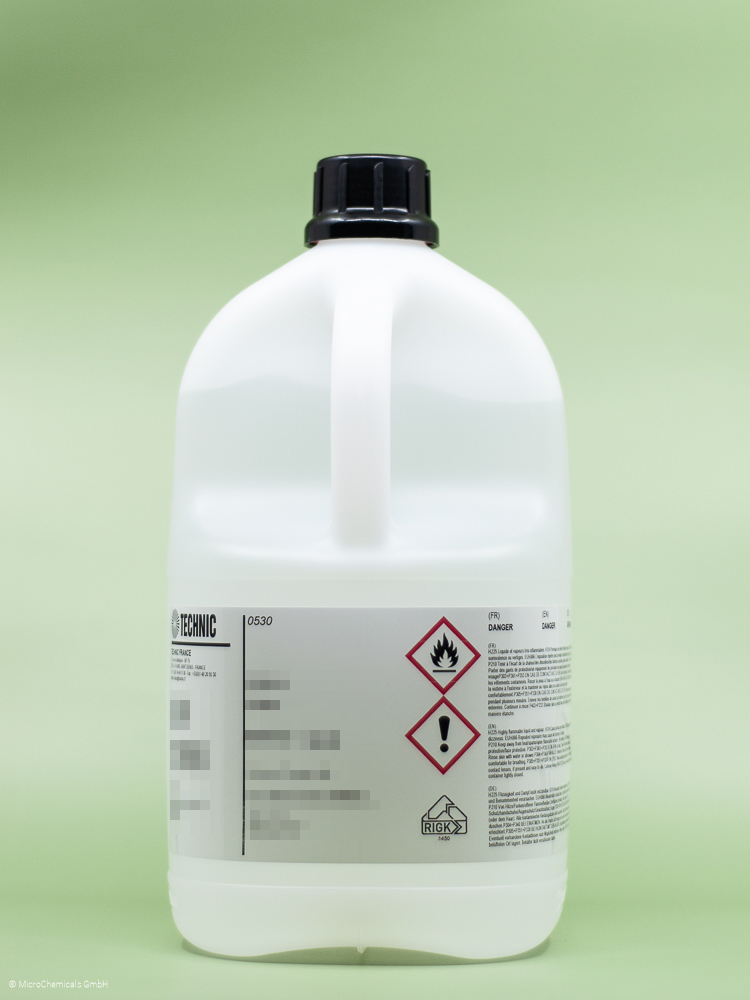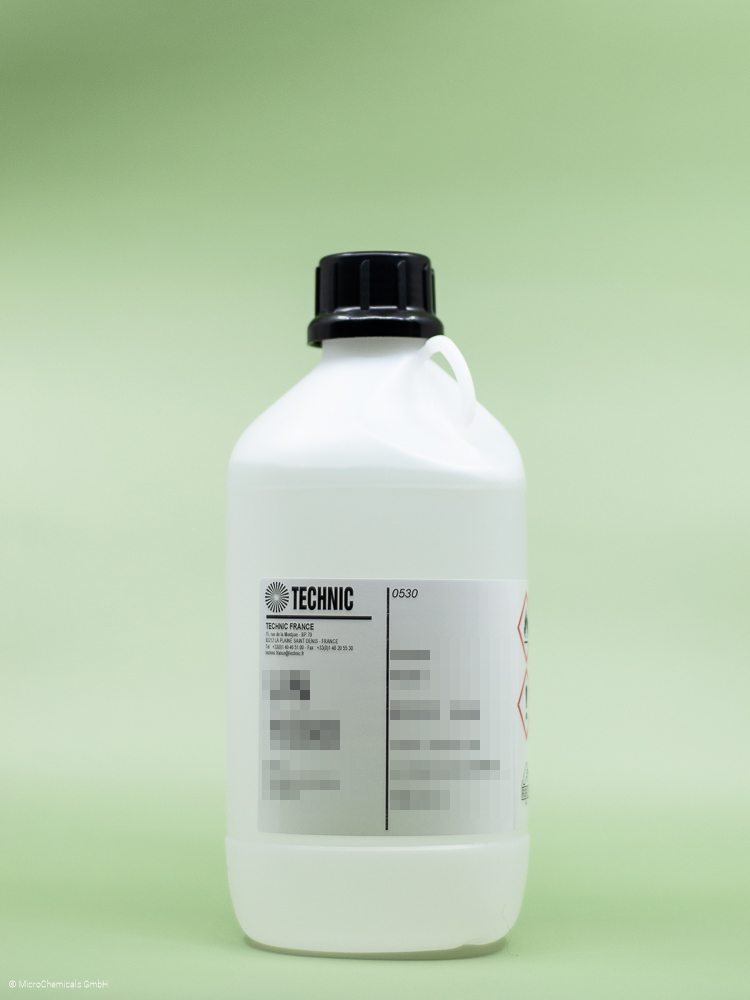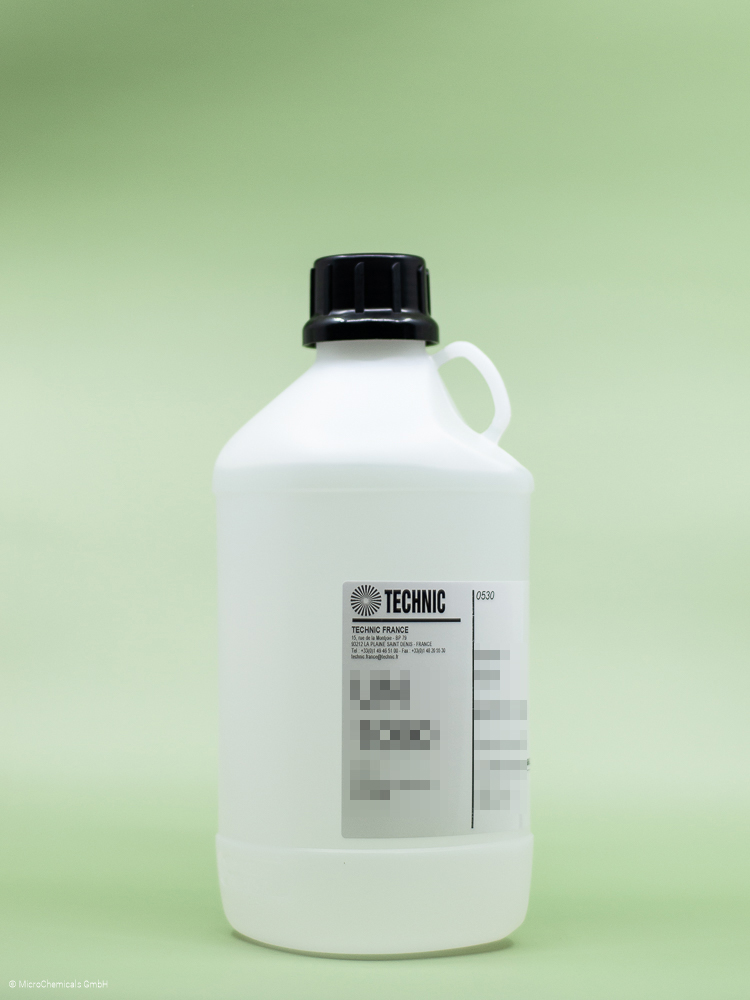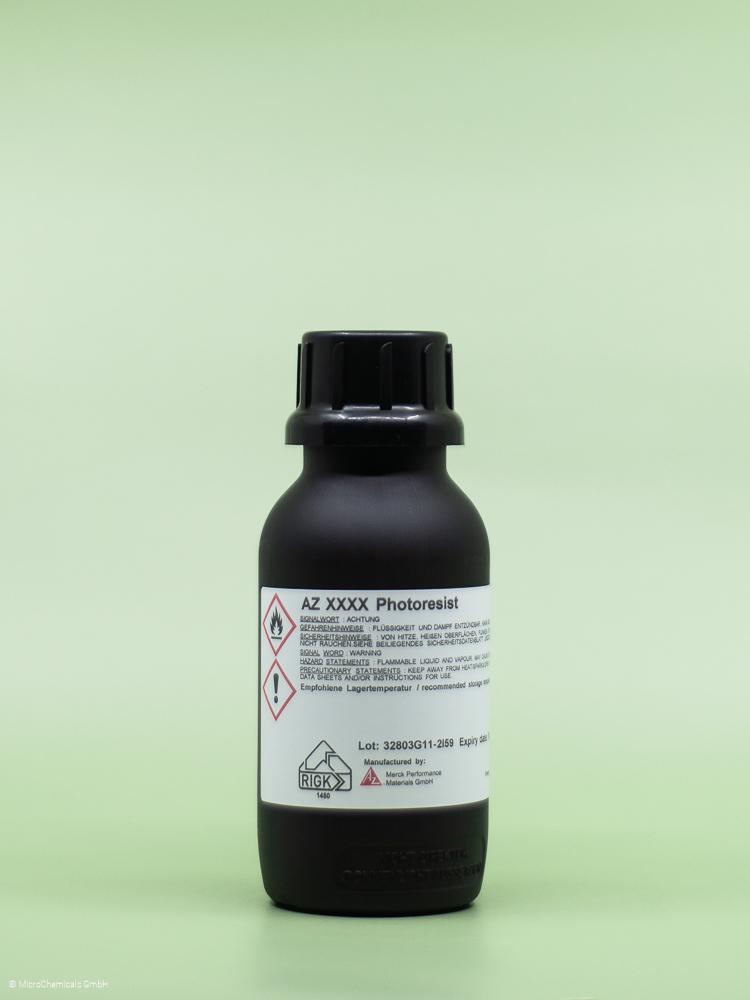Etchants
Filter
–
Acetic Acid 100 % - 2.50 l - VLSI
TESV1025
Acetic Acid
CH3COOH
General Information
Acetic Acid as surfactant and buffer is a commonly used additive for various etching mixtures.
We supply Acetic Acid (99 %) in VLSI-quality, which is the usual purity grades applied in semiconductor processing and micro-electronics.
Further Information
MSDS:
Safety Data Sheet Acetic Acid (VLSI) 100 % english
Sicherheitsdatenblatt Essigsäure (VLSI) 100 % german
Specs:
Specs Acetic Acid (VLSI) 100 %
Application Notes:
Wet Etching english
Nasschemisch Ätzen german
Ammonium hydroxide solution 28-30% - 2.50 l - VLSI - EVE/EUD!
HAMV1025
Ammonia Solution
NH4OH
General Information
Mixed with H2O2, Ammonia is an ingredient of many etching mixtures for metals such as copper, silver or aluminum.
Our Ammonia solution (28 - 30%) is available in VLSI-quality, which is the usual purity grades applied in semiconductor processing and micro-electronics.
Data on selectivity and compatibility are manufacturer information and do not claim to be complete. Please contact us for further details.
Further Information
MSDS:
Safety Data Sheet Ammonium Hydroxide Solution (VLSI) 28-30% english
Specs:
Specs Ammonium Hydroxide Solution (VLSI) 28-30%
Application Notes:
Wet Etching english
Nasschemisches Ätzen german
Au etch 200 - 5.00 l
nbtaue2005
Bottle size:
5.00 l
Au etch 200
Gold Etchant
General Information
Au etch 200 is a non-hazardous, cyanide-free, slightly alkaline etchant for Au. The etchant is used for the wet-chemical patterning of Au layers with selectivity to metals like Pt, Ni, Cr, Ti, Al. Common areas of use for semiconductor fabrication or micro system technology.
Product Properties
Low undercut (in the range of the layer thickness), minimum feature size < 1 µm
Selectivity to many materials, e.g. common metals used in electroplating industry
Available in different purity grades
Compatible to resist masking
Not hazardous substance and easy to handle
Selectivity
Au etch 200 is compatible/etches selective to following materials:
Resists: common Novolak as masking resist (e.g. AZ® Photoresist)
Metals: no attack on Pt, Ni, Cr, Ti, Al, Ta
Metals: attacked Au, Cu
Semiconductor materials: Si, SiO2, Si3N4
Data on selectivity and compatibility are manufacturer information and do not claim to be complete. Please contact us for further details.
Etching Rate
Under normal condition, the etching rate is around 40 nm/min (at 50°C). The mixed etching solution is stable over time and can be used multiple times depending on the requirements of application. It is recommended to dispose the solution at the latest, when the etching rate has changed by 20%.
Further Information
MSDS:
Safety Data Sheet Au etch 200 english
Sicherheitsdatenblatt Au etch 200 german
TDS:
Technical Data Sheet Au etch 200 english
Technical Data Sheet Au etch 200 german
Application Notes:
Wet Etching english
Nasschemisches Ätzen german
Wet Etching of Metals english
Nasschemisches Ätzen von Metallen german
Further Information about Processing
AX 100 - 5.00 l
nbtax1005
Bottle size:
5.00 l
AX 100
Activator
General Information
AX 100 is an acidic solution for activating and pretreating seed layers and metallic surfaces for electroplating, on which a direct metallization may cause problems regarding the adhesive strength. This applies e.g. for the electroplating of Au on Ni surfaces or direct electroplating on Ti or TiW layers.
AX 100 activates metallic surfaces before electroplating and allows a better adhesive strength of electroplated layers on metallic surfaces, which tend to oxidation.
Common fields of application are semiconductor fabrication and microsystem technology.
Product Properties
Low or none etch attack on metallic surfaces
Compatible to many materials, e.g. common metals used in electroplating industry
Compatible to resist masking
Not poisonous substance and easy to handle
Moderate operation temperature of about 40°C
Selectivity
AX 100 is compatible/etches selective to following materials:
Resists: common Novolak as masking resist (e.g. AZ® Photoresist)
Metals: no attack on Ni, Ti, TiW, Ta, Cu
Semiconductor materials: Si, SiO2, Si3N4
Data on selectivity and compatibility are manufacturer information and do not claim to be complete. Please contact us for further details.
Further Information
MSDS:
Safety Data Sheet AX 100 english
Sicherheitsdatenblatt AX 100 german
TDS:
Technical Data Sheet AX 100 english
Application Notes:
Further Information about Processing
BOE 7:1 (87,5 : 12,5) - 2.50 l - VLSI - EVE/EUD!
TBOV1025
BOE 7:1
Buffered Oxide Etch
General Information
BOE is mainly used for etching glasses, quartz and SiO2 films.
We supply BOE 7:1 = buffered hydrofluoric acid (HF : NH4F = 12.5 : 87.5%) in VLSI-quality, which is the usual purity grades applied in semiconductor processing and micro-electronics.
NOTE:
BOE must be stored and transported above +12.5°C. Below this critical temperature of 12.5°C the material forms particles (little crystals). Since these crystals have a higher density, they will accumulate at the bottom of the bottle and will only be completely re-dissolved when the material is stored at temperatures of 30 - 35°C for some days. After this procedure the crystals should be re-dissolved completely and the BOE can be then used without restrictions.
Further Information
MSDS:
Safety Data Sheet BOE 7:1 (VLSI) english
Sicherheitsdatenblatt BOE 7:1 (VLSI) german
Specs:
Specs BOE 7:1 (VLSI)
Application Notes:
Wet Etching english
Nasschemisches Ätzen german
Further Information about Processing
Cr etch 210 - 5.00 l - EVE/EUD!
nbtcre21005
Bottle size:
5.00 l
Cr etch 210
Chromium Etchant
General Information
Cr etch 210 is an alkaline etchant for Cr. The etchant is used for the wet-chemical patterning or removal of thin Cr layers with selectivity to metals like Au, Sn, Pt, Cu, Ni, Ti, Ta. Common areas of use are for semiconductor fabrication or microsystem technology, e.g. for the removal or patterning of a Cr barrier or adhesion layer in a plating seed stack.
Product Properties
Low undercut (in the range of the layer thickness), minimum feature size < 1µm
Selectivity to many materials, e.g. common metals used in electroplating industry
Available in different purity grades
Compatible to resist mask
Use at room temperature
Increase of the etching rate by increased temperature up to 40°C
Selectivity
Cr etch 210 is compatible/etches selective to following materials:
Resists: common Novolak as masking resist (e.g. AZ® Photoresist)
Metals: no attack on Au, Sn, Pt, Cu, Ni, Ti, Ta
Metals: attacked Cr
Semiconductor materials: Si, SiO2, Si3N4
Data on selectivity and compatibility are manufacturer information and do not claim to be complete. Please contact us for further details.
Etching Rate
Under normal condition, the etching rate is around 10 to 15nm/min at 40 °C (accordingly lower at room temperature). A sputtered 30nm Cr layer is etched in about 180 seconds. The mixed etching solution is stable over time and can be used multiple times depending on the requirements of application. It is recommended to dispose the solution at the latest, when the etching rate has changed by 20%.
Further Information
MSDS:
Safety Data Sheet Cr etch 210 english
Sicherheitsdatenblatt Cr etch 210 german
TDS:
Technical Data Sheet Cr etch 210 english
Technical Data Sheet Cr etch 210 german
Application Notes:
Wet Etching english
Nasschemisches Ätzen german
Wet Etching of Metals english
Nasschemisches Ätzen von Metallen german
Further Information about Processing
Cu etch 100 - 5.00 l - ready to use
nbtcue100rtu5
Bottle size:
5.00 l
Cu etch 100
Copper Etchant
General Information
Cu etch 100 is an alkaline etchant for Cu and is used for the wet-chemical removal of Cu layers with selectivity to metals like Ni, Au, Cr, Sn, Ti. Common areas of use are for semiconductor fabrication or microsystem technology.
Product Properties
High etching rate and rate of under etching with Cu as sacrificial layer
Selectivity to many materials, e.g. common metals used in electroplating industry
Available in different purity grades
Compatible to resist masking
Usage at room temperature
Selectivity
Cu etch 100 is compatible/etches selective to following materials:
Resists: common Novolak as masking resist (e.g. AZ® Photoresist)
Metals: no attack on Ni, Au, Cr, Sn, Ti, Pt, Ta
Metals: attacked Cu, TiW, Ag, Zn
Semiconductor materials: Si, SiO2, Si3N4
Data on selectivity and compatibility are manufacturer information and do not claim to be complete. Please contact us for further details.
Etching Rate
Under normal condition, the etching rate is around 3 to 3.5µm/min (at RT). The mixed etching solution is not stable over time (mixture of two components), but can be used multiple times depending on the requirements of application. It is recommended to dispose the solution at the latest, when the etching rate has changed by 20%.
Further Information
MSDS:
Safety Data Sheet Cu etch 100 english
Sicherheitsdatenblatt Cu etch 100 german
TDS:
Technical Data Sheet Cu etch 100 english
Technical Data Sheet Cu etch 100 german
Application Notes:
Wet Etching english
Nasschemisches Ätzen german
Wet Etching of Metals english
Nasschemisches Ätzen von Metallen german
Further Information about Processing
Cu etch 150 - 5.00 l - ready to use
nbtcue150rtu5
Bottle size:
5.00 l
Cu etch 150
Copper Etchant
General Information
Cu etch 150 is an alkaline etchant for Cu and is used for the wet-chemical removal of Cu layers with selectivity to metals like Ni, Au, Cr, Sn, Ti. Common areas of use are for semiconductor fabrication or microsystem technology.
Product Properties
Selectivity to many materials, e.g. common metals used in electroplating industry
Available in different purity grades
Compatible to resist masking
Usage at room temperature
Selectivity
Cu etch 150 is compatible/etches selective to following materials:
Resists: common Novolak as masking resist (e.g. AZ® Photoresist)
Metals: no attack on Ni, Au, Cr, Sn, Ti, Pt, Ta
Metals: attacked Cu, TiW, Ag, Zn
Semiconductor materials: Si, SiO2, Si3N4
Data on selectivity and compatibility are manufacturer information and do not claim to be complete. Please contact us for further details.
Etching Rate
Under normal condition, the etching rate is around 100 to 150nm/min (at RT). The mixed etching solution is not stable over time (mixture of two components), but can be used multiple times depending on the requirements of application. It is recommended to dispose the solution at the latest, when the etching rate has changed by 20%.
Further Information
MSDS:
Safety Data Sheet Cu etch 150 english
Sicherheitsdatenblatt Cu etch 150 german
TDS:
Technical Data Sheet Cu etch 150 english
Technical Data Sheet Cu etch 150 german
Application Notes:
Wet Etching english
Nasschemisches Ätzen german
Wet Etching of Metals english
Nasschemisches Ätzen von Metallen german
Further Information about Processing
Cu etch 200 UBM - 5.00 l
nbtcue200ubm5
Bottle size:
5.00 l
Cu etch 200 UBM
Copper Etchant
General Information
Cu etch 200 UBM is a slightly alkaline etchant for Cu and is used for the wet-chemical removal of Cu seed layers with selectivity to metals like Ni, Au, Cr, Sn, Ti, Al. Common areas of use are for semiconductor fabrication or microsystem technology especially for the removal of seed layers after the plating of under-bump-metallization (UBM).
Product Properties
Selectivity to many materials, e.g. common metals used in electroplating industry
Very small dimension lost
Available in different purity grades
Compatible to resist masking
Usage at room temperature
Selectivity
Cu etch 200 UBM is compatible/etches selective to following materials:
Resists: common Novolak as masking resist (e.g. AZ® Photoresist)
Metals: no attack on Ni, Au, Cr, Sn, Ti, Al, Pt
Metals: attack on Cu, Ag
Semiconductor materials: Si, SiO2, Si3N4
Data on selectivity and compatibility are manufacturer information and do not claim to be complete. Please contact us for further details.
Etching Rate
Under normal condition, the etching rate is around 200 to 250nm/min (at RT). The etching solution stable over time and can be used multiple times depending on the requirements of application. It is recommended to dispose the solution at the latest, when the etching rate has changed by 20%.
Further Information
MSDS:
Safety Data Sheet Cu etch 200 english
Sicherheitsdatenblatt Cu etch 200 german
TDS:
Technical Data Sheet Cu etch 200 english
Technical Data Sheet Cu etch 200 german
Application Notes:
Wet Etching english
Nasschemisches Ätzen german
Wet Etching of Metals english
Nasschemisches Ätzen von Metallen german
Further Information about Processing
Hydrochloric Acid 37% - 2.50 l - VLSI - EVE/EUD!
HHCV1025
Hydrochloric Acid
HCI
General Information
Hydrochloric Acid is an ingredient of various etching mixtures for e.g. ITO, Silver and (together with HNO3 as aqua regia) gold. HCl is suited for the removal of oxide films on many metals.
Our Hydrochloric Acid (37%) is available in VLSI-quality, which is the usual purity grades applied in semiconductor processing and micro-electronics.
NOTE:
HCl (hydrogen chloride), is a gas that dissolves very well in water and forms hydrochloric acid in dissolved form. With a molar mass of 36 g / mol, hydrogen chloride is a very small molecule, which means that it can diffuse through polymers very well. For reasons of purity, the hydrochloric acid is filled in HD-PE polymer bottles. In order to protect the bottles from particles and contaminations, these bottles (which are intended for the use in clean rooms) are packed in plastic bags. Over the time of storage, however, the hydrogen chloride diffuses through the wall of the bottle, which is made of polymer, and collects in the foil bag. There is air that contains not only carbon dioxide but also water vapor and it can react with the hydrogen chloride, whereby either a white dust or fine droplets can be found in the foil bag. This happens during storage even if there is not the slightest leak in the bottles. This white dust or the possible fine droplets are the reason why the 37% hydrochlo¬ric acid, unlike e.g. sulfuric acid of the same degree of purity, has not a shelf life of 3 years, but is only „durable“ for 1 year. It is therefore not the reason that the acid would not maintain its purity or its properties, but rather the label and also the bottles or foil bags are increasingly affected by the problem described above in the course of storage.
Further Information
MSDS:
Safety Data Sheet Hydrochloric Acid 37% (VLSI) english
Sicherheitsdatenblatt Salzsäure 37% (VLSI) german
Specs:
Specs Hydrochloric Acid 37% (VLSI)
Application Notes:
Wet Etching english
Nasschemisches Ätzen german
Further Information about Processing
Hydrofluoric Acid EVE 1% - 2.50 l - VLSI - EVE/EUD!
TAHV0125
Concentration:
1 %
Hydrofluoric Acid
HF
General Information
Hydrofluoric Acid is mainly used for etching glasses, quartz and SiO2 films as well as (mixed with HNO3) for isotropic silicon etching.
We supply hydrofluoric acid (1%, 10% and 50%) in VLSI-quality, which is the usual purity grades applied in semiconductor processing and micro-electronics.
Further Information
MSDS:
Safety Data Sheet Hydrofluoric Acid 1% (VLSI) english
Sicherheitsdatenblatt Hydrofluoric Acid 1% (VLSI) german
Safety Data Sheet Hydrofluoric Acid 10% (VLSI) english
Sicherheitsdatenblatt Hydrofluoric Acid 10% (VLSI) german
Safety Data Sheet Hydrofluoric Acid 50% (VLSI) english
Sicherheitsdatenblatt Hydrofluoric Acid 50% (VLSI) german
Specs:
Specs Hydrofluoric Acid 1% (VLSI)
Specs Hydrofluoric Acid 10% (VLSI)
Specs Hydrofluoric Acid 50% (VLSI)
Application Notes:
Wet Etching english
Nasschemisches Ätzen german
Further Information about Processing
Hydrogen peroxide 30% - 2.50 l - VLSI - PERSO+EVE/EUD!
THOV1025
Hydrogene Peroxide
H2O2
General Information
H2O2 is an ingredient of the Piranha-etch, RCA-1 and RCA-2 etching solutions, as well as etching solutions for various III/V-semiconductors.
H2O2 (30%) is available in VLSI-quality, which is the usual purity grades applied in semiconductor processing and micro-electronics.
Further Information
MSDS:
Safety Data Sheet Hydrogen Peroxide 30% (VLSI) english
Sicherheitsdatenblatt Hydrogen Peroxide 30% (VLSI) german
Specs:
Specs Hydrogen Peroxide 30% (VLSI)
Application Notes:
Wet Etching english
Nasschemisches Ätzen german
Further Information about Processing
KOH 44% - 2.50 l - VLSI
TKOV1025
KOH
Potassium Hydroxide
General Information
KOH is mainly used for anisotropic silicon etching.
We supply KOH (44 %) in VLSI-quality, which is the usual purity grades applied in semiconductor processing and micro-electronics.
Further Information
MSDS:
Safety Data Sheet KOH Solution 44% (VLSI) english
Sicherheitsdatenblatt KOH Solution 44% (VLSI) german
Specs:
Specs KOH Solution 44% (VLSI)
Application Notes:
Wet Etching english
Nasschemisches Ätzen german
Further Information about Processing
Nitric Acid 69.5% - 2.50 l - (VLSI) - PERSO+EVE/EUD!
TSAV1025
Nitric Acid
HNO3
General Information
Nitric Acid is the oxidizing ingredient of many etching mixtures for e.g. Silver, Copper, Aluminium, Silicon, Germanium and (together with HCl as aqua regia) Gold.
We supply Nitric Acid (69%) in VLSI-quality, which is the usual purity grades applied in semiconductor processing and micro-electronics.
Further Information
MSDS:
Safety Data Sheet Nitric Acid 69,5% (VLSI) english
Sicherheitsdatenblatt Nitric Acid 69,5% (VLSI) german
Specs:
Specs Nitric Acid 69,5% (VLSI)
Application Notes:
Wet Etching english
Nasschemisches Ätzen german
Further Information about Processing
Phosphoric Acid 85% - 2.50 l - (VLSI)
TPHV1025
Phosphoric Acid
H3PO4
General Information
Phosphoric Acid mixed with HNO3 is an ingredient of many etching mixtures for e.g. Aluminium and many other metals.
We supply Phosphoric Acid (85%) in VLSI-quality, which is the usual purity grades applied in semiconductor processing and micro-electronics.
Further Information
MSDS:
Safety Data Sheet Phosphoric Acid 85% (VLSI) english
Sicherheitsdatenblatt Phosphoric Acid 85% (VLSI) german
Specs:
Specs Phosphoric Acid 85% (VLSI)
Application Notes:
Wet Etching english
Nasschemisches Ätzen german
Further Information about Processing
Sulfuric Acid 96% - 2.50 l - VLSI - PERSO+EVE/EUD!
TSWV1025
Sulfuric Acid
H2SO4
General Information
A mixture of Sulfuric Acid with H2O2 is a powerful stripper for organic impurities or residuals on substrates.
We supply Sulfuric Acid (96%) in VLSI-quality, which is the usual purity grades applied in semiconductor processing and micro-electronics.
Further Information
MSDS:
Safety Data Sheet Sulfuric Acid 96% (VLSI) english
Sicherheitsdatenblatt Sulfuric Acid 96% (VLSI) german
Specs:
Specs Sulfuric Acid 96% (VLSI)
Application Notes:
Wet Etching english
Nasschemisches Ätzen german
Further Information about Processing
TechniEtch ACI2 - 5.00 l - VLSI
TEACI2V5
Bottle size:
5.00 l
TechniEtch™ACI2
Gold Etchant
General Information
TechniEtch™ACI2 is a highly effective and selective gold stripper. TechniEtch™ACI2 is an Iodine based Gold etchant, containing particular additives that greatly enhance stability and metal loading capability compared to conventional I2/I3 - based solutions .
Product Properties
High etch rate at room temperature
Low surface tension for enhanced wetting property
High stability even in presence of metal contamination (Cu, Ni…).
Loading & bath life independent of the solution Cu contamination level (up to 1g/l)
Enlarged loading capacity compared to standard I2/KI based solutions.
Better process controllability/reliability.
Low Toxicity compared to cyanide and HF/HNO3 based solutions
Selectivity
TechniEtch™ACI2 is compatible/etches selective to following materials:
Metals: no attack on Ni, Al, Ti, TiN
Metals: attack on Au, Cu, Sn, Pt, W
Semiconductor materials: Si, SiO2, Si3N4
Data on selectivity and compatibility are manufacturer information and do not claim to be complete. Please contact us for further details.
Further Information
MSDS:
Safety Data TechniEtch™ACI2 (VLSI) english
Sicherheitsdatenblatt TechniEtch™ACI2 (VLSI) german
TDS:
Technical Data Sheet TechniEtch™ACI2 (VLSI) english
Specs:
Specs TechniEtch™ACI2 (VLSI)
Application Notes:
Wet Etching english
Nasschemisches Ätzen german
Wet Etching Metals english
Nasschemisches Ätzen von Metallen german
Further Information about Processing
TechniEtch Al80 - 2.50 l - MOS
TAEV1025
TechniEtch Al80
Aluminium Etchant
General Information
TechniEtch Al80 is a ready-to-use etching mixture based on phosphoric acid, nitric acid and acetic acid for aluminium etching. Our aluminium etchant TechniEtch Al80 has the composition H3PO4 : HNO3 : CH3COOH* : H2O = 80% : 5% : 5% : 10% comes in MOS quality.
Product Properties
High etch rate at room temperature.
High stability even in presence of metal contamination
Loading & bath life mainly dependent of process temperature, tool and extraction flow
Selectivity
TechniEtch Al80 is compatible/etches selective to following materials:
Metals: no attack on Au, Pt
Metals: attack on Al
Data on selectivity and compatibility are manufacturer information and do not claim to be complete. Please contact us for further details.
Further Information
MSDS:
Safety Data TechniEtch Al80 (MOS) english
Sicherheitsdatenblatt TechniEtch Al80 (MOS) german
TDS:
Technical Data Sheet TechniEtch Al80 (MOS) english
Specs:
Specs TechniEtch Al80 (MOS)
Application Notes:
Wet Etching english
Nasschemisches Ätzen german
Wet Etching Metals english
Nasschemisches Ätzen von Metallen german
Further Information about Processing
TechniEtch CN10 Concentrate - 2.50 l - MOS - EVE/EUD!
TPCN1025
TechniEtch™ CN10
Copper and Nickel Etchant
General Information
TechniEtch™ CN10 is a copper and nickel etchant, which is a mixture of nitric- and phosphoric acid.
The etching process should be carried out with an addition of 8-16 % Hydrogenperoxide (30 %).
At 25° C the etching rate is approx. 0.3-0.4 µm per minute. Without the Addition of Hydrogenperoxide the etching rate is significantly lower and less homogenous.
TechniEtch CN10 (90 s RT Cu seed removal)
Product Properties
Better process controllability/reliability
High stability even in presence of metal contamination
Selectivity
TechniEtch™ CN10 is compatible/etches selective to following materials:
Metals: no attack on Ti, TiN
Metals: attack on Cu, Ni
Data on selectivity and compatibility are manufacturer information and do not claim to be complete. Please contact us for further details.
Further Information
MSDS:
Safety Data TechniEtch™ CN10 (MOS) english
Sicherheitsdatenblatt TechniEtch™ CN10 (MOS) german
TDS:
TF Technical Data Sheet TechniEtch™ CN10 (MOS) english
MC Technical Data Sheet TechniEtch™ CN10 (MOS) english
Mixing TechniEtch™ CN10 (MOS) english
Specs:
Specs TechniEtch™ CN10 (MOS)
Application Notes:
Wet Etching english
Nasschemisches Ätzen german
Wet Etching Metals english
Nasschemisches Ätzen von Metallen german
Further Information about Processing
TechniEtch Cr01 - 2.50 l - VLSI
TCEV1025
TechniEtch Cr01
Chromium Etchant
General Information
TechniEtch Cr01 is a ready-to-use etching mixture based on ceric ammonium nitrate and perchloric acid for Cr etching.
TechniEtch Cr01 consists of ceric ammonium nitrate : Perchloric acid : water = 10.9% : 4.25% : 84.85% with an etching rate of about 60 nm/minute at room temperature comes in VLSI quality.
Product Properties
Cr etch rate at room temperature 60-100 nm/min
Al, Ti, W, Ni @ RT from 10nm/min to 200 nm/min
Cu, Ag, V are heavily etched > 200 nm/min
Au, Pd, Pt are compatible
Compatible with positive tone resin
Can be diluted down to adjust Cr etch rate
Selectivity
TechniEtch Cr01 is compatible/etches selective to following materials:
Metals: no attack on Au, Pd, Pt
Metals: attack on Cr, Fe, Mo, Ni, Al, Ti, W, Cu, Ag, V, Co, Mg, Mn, Sn
Data on selectivity and compatibility are manufacturer information and do not claim to be complete. Please contact us for further details.
Further Information
MSDS:
Safety Data TechniEtch Cr01 (VLSI) english
Sicherheitsdatenblatt TechniEtch Cr01 (VLSI) german
TDS:
Technical Data Sheet TechniEtch Cr01 (VLSI) english
Specs:
Specs TechniEtch Cr01 (VLSI)
Application Notes:
Wet Etching english
Nasschemisches Ätzen german
Wet Etching Metals english
Nasschemisches Ätzen von Metallen german
Further Information about Processing
TechniEtch TBR 19 Concentrate - 0.50 l - MOS
TETBR190500
Bottle size:
0.50 l
TechniEtch™ TBR19 Concentrate
Ti, TiW and TiN Etchant
General Information
TechniEtch™ TBR19 is a low undercut Ti etch chemistry concentrate for Cu bump pillars for self-mixing. TechniEtch™ TBR19 concentrate is compatible with most under bump metallization (UBM) and copper pillar integration materials such as Cu, Al, Ni and alloys, glass, organic substrate and most plastics like polypropylene, HDPE, PFA, PTFE Kalrez, PEEK, PE. The etching rate at 50°C is around 1000 A/min.
Note:
To mix the TechniEtch™ TBR19 Concentrate correctly, a mixing ratio of 94 : 6 (94 wt % H2O2 and 6 wt % TBR19 concentrate additives) is recommended.
This means that after mixing 500ml of TechniEtch™ TBR19 Concentrate with the corresponding amount of H2O2, you will obtain approx. 8 litres of the finished etching solution.
TBR19 (150°C 180s underetch smaller than 500nm)
Product Properties
High selectivity
Significant reduction of undercut compared to conventional SC1 and HF
Long bath life
Tunable etch rate
Selectivity
TechniEtch™ TBR19 is compatible/etches selective to following materials:
Metals: no attack on Cu, Al, Ni, Sn
Metals: attack on TiN, TiW, Ti, SnPd
Data on selectivity and compatibility are manufacturer information and do not claim to be complete. Please contact us for further details.
Further Information
MSDS:
Safety Data TechniEtch TBR 19 (MOS) english
Sicherheitsdatenblatt TechniEtch TBR 19 (MOS) german
TDS:
Technical Data Sheet TechniEtch TBR 19 (MOS) english
Mixing Technical Data Sheet TechniEtch TBR 19 (MOS) english
Specs:
Specs TechniEtch TBR 19 (MOS)
Application Notes:
Wet Etching english
Nasschemisches Ätzen german
Wet Etching Metals english
Nasschemisches Ätzen von Metallen german
Further Information about Processing
TiW Etch 100 - 5.00 l
nbttiw1005
Bottle size:
5.00 l
TiW etch 100
Titan-Wolfram Etchant
General Information
TiW etch 100 is applied as etchant for Titan-Wolfram layers. Usual applications are found in the semiconductor or microsystem technology field for etching adhesion layers or diffusion barriers.
Product Properties
Low undercut (in the range of the layer thickness), minimum feature size < 1µm
Selectivity to many materials, e.g. common metals used in electroplating industry
Compatible to resist masking
Selectivity
TiW etch 100 is compatible/etches selective to following materials:
Resists: common Novolak as masking resist (e.g. AZ® Photoresist)
Metals: no attack on Au, Pt, Ni, Cr, Sn
Metals: attack on TiW, Cu
Cu impact at prolonged exposition
Semiconductor materials: Si, SiO2, Si3N4
Data on selectivity and compatibility are manufacturer information and do not claim to be complete. Please contact us for further details.
Etching Rate
Under normal condition, the etching rate is around 1nm/sec (at room temperature). The mixed etching solution is stable over time and can be used multiple times depending on the requirements of application. It is recommended to dispose the solution at the latest, when the etching rate has changed by 20%.
Further Information
MSDS:
Safety Data Sheet TiW etch 100 english
Sicherheitsdatenblatt TiW etch 100 german
TDS:
Technical Data Sheet TiW etch 100 english
Technisches Datenblatt TiW etch 100 german
Application Notes:
Wet Etching english
Nasschemisches Ätzen german
Wet Etching of Metals english
Nasschemisches Ätzen von Metallen german
Further Information about Processing
TiW Etch 200 - 5.00 l
nbttiw2005
Bottle size:
5.00 l
TiW etch 200
Titan-Wolfram Etchant
General Information
TiW etch 200 is applied as etchant for titanium-wolfram layers. Usual applications are found in the semiconductor or microsystem technology field for etching adhesion layers or diffusion barriers.
Product Properties
Low undercut (in the range of the layer thickness), minimum feature size < 1µm
Selectivity to many materials, e.g. common metals used in electroplating industry
Compatible to resist masking
Selectivity
TiW etch 200 is compatible/etches selective to following materials:
Resists: common Novolak as masking resist (e.g. AZ® Photoresist)
Metals: no attack on Au, Pt, Ni, Cr
Metals: attacked TiW, Cu
Semiconductor materials: Si, SiO2, Si3N4
Data on selectivity and compatibility are manufacturer information and do not claim to be complete. Please contact us for further details.
Etching Rate
Under normal condition, the etching rate is around 5nm/min (at room temperature). The mixed etching solution is stable over time and can be used multiple times depending on the requirements of application. It is recommended to dispose the solution at the latest, when the etching rate has changed by 20%.
Further Information
MSDS:
Safety Data Sheet TiW etch 200 EN
Sicherheitsdatenblatt TiW etch 200 DE
TDS:
Technical Data Sheet TiW etch 200 EN
Technisches Datenblatt TiW etch 200 DE
Application Notes:
Wet Etching
Nasschemisches Ätzen
Wet Etching of Metals
Nasschemisches Ätzen von Metallen
Further Information about Processing
TMAH 25% - 2.50 l - VLSI - EVE/EUD!
TTMV1025
TMAH
Tetramethylammonium hydroxide
General Information
TMAH is mainly used for anisotropic silicon etching when metal ion free processing is required.
TMAH (25%) is available in VLSI-quality, which is the usual purity grades applied in semiconductor processing and micro-electronics.
Further Information
MSDS:
Safety Data Sheet TMAH 25 % (VLSI) english
Sicherheitsdatenblatt TMAH 25 % (VLSI) german
Specs:
Specs TMAH 25 % (VLSI)
Application Notes:
Wet Etching english
Nasschemisches Ätzen german



